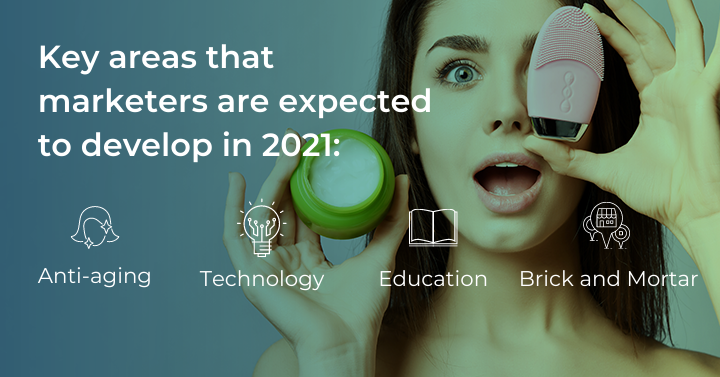The market for beauty devices is poised for another year of growth, with expected increases of mid-single digits in the United States and an even stronger double-digit rate in China. And while last year’s category gains were undoubtedly driven by the COVID-19 pandemic, sustainable growth seems likely. To boost sales even further, marketers are expected to embrace the following key areas:
- Anti-aging or pro-aging powered/non-powered devices
Shoppers are flocking to devices that offer single and multiple technologies. And while consumers have always had an interest in ways to treat fine lines and wrinkles, that interest has expanded to younger consumers who are beginning to use these devices in their 20s―and even going for Botox.
- Technology such as radio frequency (RF) outside of the United States and microcurrent/nanocurrent
Although the anti-aging devices category achieved success due to the popularity of LED technology, marketers are beginning to introduce new anti-aging devices based on varied technologies, with RF and microcurrent/nanocurrent being the most popular and efficacious. In 2020, Ya-Man, with its Bloom device, and Tripollar, with its Stop Vx device, utilized the power of RF technology. Microcurrent/nanocurrent technology has also been successfully used by NuFace, Ziip Beauty, and ReFa.
- Educational support
Brands offering educational support will win over consumers, helping them get maximum use of their devices and explore other brand products. With that in mind, marketers have upped their game by advancing from basic tutorial videos on YouTube to IG Live sessions with experts. NuFace, for example, conducted Live IG sessions with its co-founder Tera Valdez and other celebrities, while Dr. Dennis from Dr. Dennis Gross Skincare organized free master classes for consumers through 2020.
- Skin care product offerings
Beauty device marketers are expected to focus on expanding their topical skin care lines to offer consumers a variety of products to be used in conjunction with devices. Marketers stand at the crossroad of adopting a two-pronged approach, either focusing on developing their own line or collaborating/partnering with skin care companies.
- Brick-and-mortar
There’s no disputing the fact that direct sales account for the majority of category sales, but as consumers get vaccinated against coronavirus, they’ll be returning to stores. In preparation, Sephora has brought category products such as NuFace, Bio Beauty, and Foreo back into its physical stores. Other retailers, including Blue Mercury, have brought category products into their stores with an impressive collection of NuFace, along with offering education. Prestige retailers such as Nordstrom and Saks, which offer U.K.-born Face Gym, are welcoming device brands to their in-store treatment areas.
This year’s edition of Beauty Devices Global Series covers markets such as Japan, South Korea, and Europe. It will detail the latest performance of the at-home beauty devices market, following the effects of the coronavirus pandemic, including trends, opportunities, key skin care concerns, and popular technologies, plus a competitive landscape.

